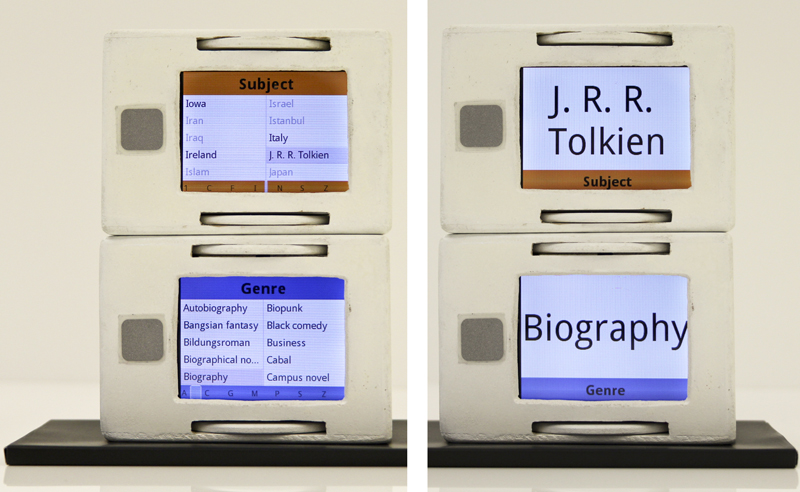Section: New Results
Tangible Visualization
Participants : Pierre Dragicevic [correspondant] , Petra Isenberg, Yvonne Jansen, Jean-Daniel Fekete.
The goal of tangible visualization is to move data and controls to the physical world in order to exploit peoples' natural abilities to perceive and to manipulate objects, and to collaborate through these objects. This is a new topic in information visualization. Physical objects can be used either to represent data (physical visualizations) or to interact with data (physical controls). We studied both.
|
Physical visualizations already exist in the form of data sculptures. Data sculptures are an increasingly popular data-driven media whose purposes are essentially artistic, communicative or educational. We are maintaining a public list of such visualizations at http://www.aviz.fr/Research/PassivePhysicalVisualizations (for passive visualizations) and at http://www.aviz.fr/Research/ActivePhysicalVisualizations (for visualizations with electronics included). But despite prolific work from the art and design communities, physical visualizations have been largely ignored in infovis research. In particular, there is no study on whether physical visualizations can help carry out actual information visualization tasks. We carried out the first infovis study comparing physical to on-screen visualizations. We focused on 3D visualizations, as these are common among physical visualizations but known to be problematic on computers. Taking 3D bar charts as an example (Figure 8 ), we showed that moving visualizations to the physical world can improve users’ efficiency at information retrieval tasks. In contrast, augmenting on-screen visualizations with stereoscopic rendering alone or with prop-based manipulation was of limited help. Our work suggests that the efficiency of physical visualizations stem from features that are unique to physical objects, such as their ability to be touched and their perfect visual realism. These findings provide empirical motivation for current research on fast digital fabrication and self-reconfiguring materials.
We also studied how physical artifacts can help explore and interact with on-screen visualizations. One project consisted in building customizable tangible remote controllers for interacting with visualizations on wall-sized displays [36] (see http://www.aviz.fr/trc ). Such controllers are especially suited to visual exploration tasks where users need to move to see details of complex visualizations. In addition, we conducted a controlled user study suggesting that tangibles make it easier for users to focus on the visual display while they interact. Another project explored the concept of stackable tangibles designed to support faceted information seeking in a variety of contexts (see http://www.aviz.fr/stackables ). Each Stackable tangible represents search parameters that can be shared amongst collaborators, modified during an information seeking process, and stored and transferred. Stackables were designed to support collaborative browsing and search in large data spaces. They are useful in meetings, for sharing results from individual search activities, and for realistic datasets including multiple facets with large value ranges.
For more information, see http://www.aviz.fr/phys .




